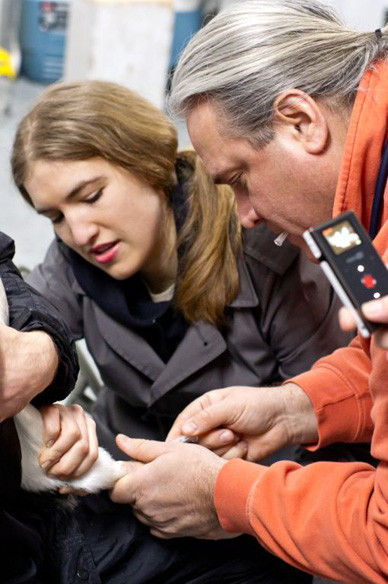Valley Stream vet cares for Mr. Popper's penguins
Dr. Laura Gorman, who works at Central Veterinary Associates in Valley Stream, never thought that she would be answering a house call for penguins. “I was on another call in Great Neck when I got this one, and I asked if it was real,” she said. “I didn’t believe it, but I ended up getting to do something that I normally don’t do.”
Gorman was one of several representatives from Central Veterinary Associates who recently completed caring for penguins that were used in the making of “Mr. Popper’s Penguins,” starring Jim Carrey.
During five months of filming, the penguins were cared for by Dr. John Charos, director of avian and exotics medicine, as well as Dr. Ernest Vine and Gorman. They were responsible for checking the penguins’ health status and preparing them for the transition to a saltwater environment.
Charos, who also serves as the senior vice president and chief operating officer of Central Veterinary Associates, has received recognition throughout his career for his work with exotics and other animals, including the ASPCA Founder’s Award and being featured in an Animal Planet documentary.
The doctor said it was wonderful to have worked with animals as exotic as these birds. “Taking care of the penguins during the making of the film was very challenging,” Charos said. “But it was also rewarding to provide these animals with the best care possible in the short amount of time we were with them.”
The penguins, born in a zoo in Canada, were sent to Steiner Studios in Brooklyn after being selected to appear in the summer children’s film. At this location, the interior of Carrey’s character’s apartment was recreated by production designer Stuart Wertzel — a clean space that changes when the penguins that the Valley Stream veterinarians took care of come along in the film.
“Once the penguins start inhabiting the apartment, it starts taking on a whole life of its own and becomes a kind of winter wonderland,” Wurtzel said in a statement.
Vine, who Gorman said had experience dealing with traveling animals and is licensed by the United States Department of Agriculture’s Animal and Plant Health Inspection Service, was required to have international health certificates to care for the penguins while they were being transported across borders.
At the movie studio, the penguins had a specially refrigerated environment that included a custom-built cold-water Jacuzzi. Charos was responsible for preparing them for their new home by adding incremental amounts of salt water to their diet, affecting certain glands that are crucial to penguins’ survival in this type of environment.
Charos said this “weaning” process allowed the vestigial supraorbital glands, which allow the penguins to live in and drink salt water and to remove the salt from the water, to fully develop again. “These unique glands allow the penguins to live without a freshwater source,” Charos said. “Since they were born in a zoo and their 12 generations before them lived in a freshwater environment, these glands begin to atrophy, like a muscle would from disuse. The weaning helped the vestigial supraorbital glands develop into fully functional glands again.”
The penguins were brought to a facility in Hong Kong after they finished filming, and will later move to China. Before they were sent to Asia, Charos and Gorman performed monthly checkups and bloodwork and tested them for West Nile Virus and Avian Influenza. The blood samples were shipped to the University of Georgia’s Infectious Disease Department.
According to Gorman, the penguins were also checked for Aspergillosis, a group of illnesses caused by mold, and Bumblefoot, a bacterial infection mostly found on the feet of birds. Although she said the birds could sometimes be “tricky” to handle during examinations, Gorman said working with the penguins on set was an exciting experience.
“They were so interesting, and even if they were mean, they were always smart and beautiful,” she said. “Birds are great to work with in general. Normally, people only think of dogs as having these great personalities, but birds do, too.”






